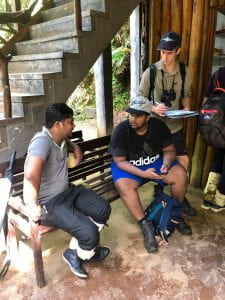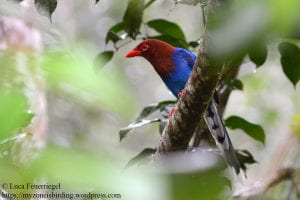After being cancelled in March due to the terrorist attacks, I was really excited for the Geography field trip to the Sinharaja Rainforest in September. We spent two and a half days in Martin’s Lodge, a basic accommodation close to the small town of Kudawa and right on the edge of the magnificent Sinharaja Rainforest. The purpose of the trip was to conduct surveys for the Geography IA, so that is an academic aspect that does not qualify as CAS. However, this trip included CAS aspects in the areas of activity and creativity.

Our group in the forest. Photo courtesy: Chandralatha (a guide in Sinharaja).
The survey was conducted over two days. We were split up in groups of twos (I conducted the survey together with Seth) and were joined by a guide from the forest reserve, who know the area and hence lead us along the roads to houses where we conducted the interviews. In total, all groups collected 55 surveys, resulting in data on land use, involvement in the tourism industry, waste management and other topics. The surveys were interesting for me not only because I got to know things that we asked people about in the survey, but also as I experienced rural life in Sri Lanka, which I did not really have the opportunity to do before. It was moving to see how some people manage to live a life with so few means compared to us, who have so much more than we really need.

Seth and I conducting a survey with one of the park’s guides. Photo courtesy: Ian Lockwood.
In the afternoons, we did not conduct surveys, and spent the time hiking in the forest, soaking in the nearby forest stream and doing other fun social activities. As I am passionate about nature, particularly about birds, this was a great opportunity for me to enjoy the forest and share my passion with the other students. The hiking we did was tiring in the hot and humid forest, and the leeches were relentless. Nonetheless, we had some great experiences, including sightings of several species of snakes and many endemic birds, including two I have never seen before. There were good photographic opportunities, and I enjoyed being able to improve my photographic skills as I brought my camera along. I improved slightly with setting the right manual settings and even improving my manual focus accuracy, which is surprising considering the trip was very short. I published a trip report with photos on my private birding blog as well.

Sri Lanka Blue Magpie. I took this photo of this endemic bird species in the rainforest.

Sri Lanka Green Pit Viper. I took this photo of the snake which was right at our accommodation.
Martin, the owner of the lodge where we stayed, is a very interesting person. He is 80 years old and has experienced a great deal in the area since he moved there in 1957. We asked him several questions and it was a great experience to gain some insight into his life. He was involved in protecting the forest from logging in the 60s and 70s, and became one of the central figures in the conservation of the park. He did talks at events and universities, but now he says his voice is too weak. What was impressive is that he told us he discovered five new species of plant in the forest.

Serendib Scops Owl. I took this photo right at the end of the trip. It is a bird that I wanted to see ever since I knew we would be moving to Sri Lanka.
On the final half day that we had, we did a hike to a mountain in the forest, called Mulawella. The climb was steep and slippery, but we were not in a rush and in the end, everyone reached the top – a boulder from which one can look over the rainforest until it disappears in the horizon. This was an incredible sight, and the hike was definitely worth it according to the group. It was an amazing feeling to see the diversity and colors of the forest, and simply knowing how many beautiful species of animals occur in the area. Just before we left some of us went on a tough climb on a nearby slope, where a very rare species of owl was roosting. It’s called the Serendib Scops Owl, which was only discovered in 2001 (the year I was born!) and described to science in 2004. We saw the birds from a distance of only 3m, quietly looking at us from their roost – this was a very exhilarating experience, and a great way to end to trip.
